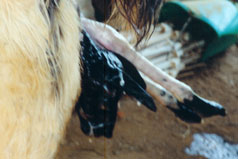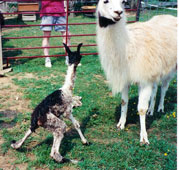A Llama Birth - Joy
![]()
 |
 |
 |
| Most births occur from a standing position, and presentation is usually the nose of the cria. Occasionally the mom may lie down and sometimes the feet come out first. | Here, the head is finally out. Now the cria coughs and sneezes, but really doesn't have to breathe as the umbilical cord is still attached. Mom may take a extended break from pushing at this point to allow time for more dilation as the big shoulders are next. | As the cria eases out past the shoulders, this dangling allows all the fluids to drain from the lungs. |
 |
 |
 |
| Slowly the cria drops to the ground. Once those shoulders are out, the umbilical cord is broken and hitting the ground helps to jump start the breathing. Sometimes we help the cria drop so the thump isn't quite so hard! | As this cria was being born in the barn on a dirt floor, we toweled her dry to avoid her rolling around in the dirt. | Here mom and newborn greet each other. Moms may start humming to their crias during the actual birth process. This helps the cria identify mom in the future. |
 |
 |
 |
| Moms don't lick their crias dry like in other species - so we have moved cria and mom out into the sun to help with the drying process. | Strong crias can roll themselves into this kush position right away. Mom is resting and baby is just building up strength to attempt to stand | Here we go! |
 |
 |
 |
| Made it! | Now to find the milk! Since there is no passive transfer of antibodies in the womb, it is extremely important for crias to get that first colostrum from mom. That is how they build their initial immune system. | Here she is- standing with a full tummy! LJB Abundant Joy! |
 |
 |
 |
| We try to keep mom and cria separate from the herd for a few hours to give them some bonding time. Plus everyone else in the herd is so interested in the newest addition that they all want to greet her! | Finally, time for a nap. | Most crias stick pretty close to their moms for quite some time. Still, they do venture off to explore and play with the other crias. |
•
Last Updated 13 December 2003